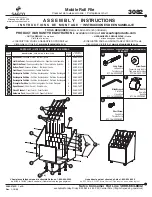
SAFETY PRECAUTIONS
IT IS IMPORTANT TO READ THIS SAFETY NOTICE PRIOR TO OPERATING ANY
EQUIPMENT
First Aid
IF IN DOUBT, SEEK IMMEDIATE MEDICAL ATTENTION. If any
quantity of liquid nitrogen comes into contact with the skin or eyes,
immediately flood that area of the body with large quantities of unheated
water, apply cold compresses and seek medical attention. If the skin is
blistered or there is any possibility that eyes have been affected, the patient
should be taken immediately to a doctor or hospital for treatment.
Safety
Failure to comply with these instructions could result in personal
injury
Operating the system in a manner not specified within in this manual or under conditions
outside of the specifications, see Appendix A, may result in the protection offered by the
equipment being impaired.
Avoid nitrogen build up: anywhere liquid nitrogen is used must be well ventilated to
reduce the risk of nitrogen build up. Small volumes of liquid nitrogen convert to very
large volumes of gas. This can result in drowsiness, or in extreme cases, asphyxiation.
When liquid nitrogen is used in confined spaces, oxygen-deficiency alarms must be
installed. Guidance on ventilation requirements are given in
BCGA Code of Practice
CP30, The safe use of liquid nitrogen dewars up to 50 litres.
When there is a risk of reduced or insufficient ventilation when a room is unoccupied,
then alarms to indicate oxygen deficiency must be installed and positioned outside of the
room so that operators are aware of the hazard before entering. The operational status of
such an alarm should also be visible from outside the room.
If liquid nitrogen is used in an area that requires forced ventilation, an alarm to indicate
its failure should be fitted.
When dispensing or potentially being exposed to liquid nitrogen, protect the face with a
shield and wear gloves, boots and a protective apron. Prevent spillage into shoes and onto
unprotected parts of the body.
Handle vessels containing liquid nitrogen carefully. Liquid nitrogen boils at -196ºC and
both liquid and gas can cause rapid and severe frostbite. Delicate tissue, e.g. the eyes, can
be damaged by an exposure to the cold gas, which may be too brief to affect the skin of
the hands or face.
Stand clear of boiling and splashing liquid nitrogen and its gas when filling a dewar at
normal room temperature or when inserting objects (such as a pump) into the liquid.
Use tongs or wear cryogloves when handling cold or hot objects. Cryogloves are available
as an accessory from Planer Biomed. When running a program, the chamber and contents
may get cold enough to cause frostbite.
The dewar must be depressurised before the pump can be removed. This is achieved by
opening the pressure-release valve mounted on the side of the pump, which seals an
Safety iii
Summary of Contents for Kryo550-16
Page 1: ...Kryo550 16 Operator s Manual...
Page 9: ...C 1 Safety Declaration Contents vii...
Page 10: ...viii Contents...
Page 18: ...1 8 Introduction to the Kryo550 16...
Page 24: ...2 6 Installing the Kryo550 16...
Page 30: ...3 6 Freezing Samples...
Page 34: ...4 4 Routine Maintenance and Troubleshooting...
Page 38: ...B 2 Alarm Output...
Page 41: ......
Page 42: ......






































